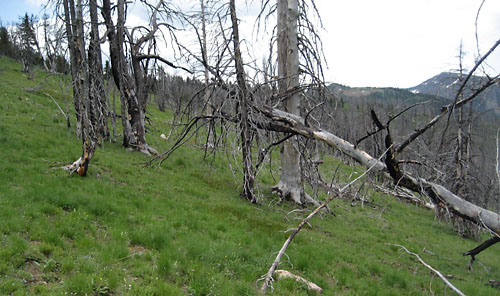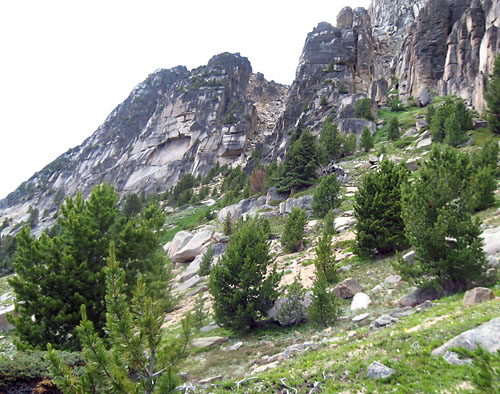|

Comments Still Wanted
Update: 7/10/13
The Forest Service is still seeking public comments about a proposal to plant whitebark pine this fall on Quartz Mountain in the Pasayten Wilderness north of Winthrop. If implemented, 1,000 whitebark pine seedlings would be planted in an area where the species existed before being killed in the 2002 Quartz Mountain Fire.
The legal notice for the project was published on July 4. The comment period on the proposal runs for 30 days.
“In order to maintain whitebark pine on Quartz Mountain, as well as on the greater landscape, there is a need to improve the future seed pool within the area burned by the Quartz Mountain Fire,” said Michael Liu, Methow Valley District Ranger.
Additional information about the proposed project is available by contacting Connie Mehmel, Project Lead, at (509) 664-9213 or at 1133 North Western Avenue, Wenatchee, WA 98801
The preliminary Environmental Assessment and a map of the project area are also available online at www.fs.fed.usda.gov/goto/okawen/projects.
Whitebark Assist
Planting in Wilderness proposed
The Methow Valley Ranger District is seeking comments on a proposal to plant whitebark pine seedlings on Quartz Mountain, about in the center of the Pasayten Wilderness, near Canada, according to a district news release.
 The Quartz Fire burned hard over Quartz Mountain in 2002: no trees have regenerated in the last decade. Photo by Connie Mehmel, courtesy of the Okanogan-Wenatchee National Forest It’s a first. “There has been no planting of regeneration of a particular species,” in the wilderness said Connie Mehmel, who is leading the project for the Okanogan-Wenatchee National Forest, though crews have planted vegetation “for restoration of trampled sites.”
The plan is long-range: the first cones on the trees planted in such a high, harsh environment would be expected in 20 to 30 years, Mehmel said, and it would take up to 60 or 80 years before the trees were producing a solid crop of whitebark pine cones and seeds. “It takes a lot longer than something like a lodgepole.”
“Much of the whitebark pine habitat in the area was burned by wildfires in 2002 and replanting whitebark pine seedlings would improve the potential seed source for future regeneration,” according to the news release. The Forest Service proposes planting about four acres in the Quartz Mountain area with 1,000 whitebark pine seedlings this September. “The seedlings are from native stock and are thought to have some level of natural resistance to blister rust. Autumn rains should provide moisture for the newly planted seedlings.”
A crew of 10 workers would bring in seedlings, tools and overnight equipment on pack stock. Planting would take about two days, with one or two nights spent at an established campsite about three miles south of the US/Canadian border.
Large fires in 2002 consumed about 630 acres of Quartz Mountain whitebark pine habitat. In 2012, searchers found no tree seedlings on the former whitebark site and no cone-bearing whitebark pine near the former stands. “It is unlikely to regenerate naturally,” according to the news release. “This project is designed to establish a small island of live whitebark pine in the burned area in order to provide a future seed source and set the stage for long-term whitebark pine regeneration.”
 Young whitebark pines stand near Cathedral Peak in 2009. The trees were about 30 years old and starting to put out a few cones, according to photographer Connie Mehmel. “2009 was a good whitebark cone year almost everywhere we looked in the Pasayten.” Photo courtesy of the Okanogan-Wenatchee National Forest The Quartz Mountain burned area is ideal for white bark restoration, said Michael Liu, Methow Valley District Ranger. “There is a demonstrated need, it is accessible from existing trails and packer campsites, and there are seedlings available that are suitable for the location.”
Whitebark pine grows at high elevation and is found only in western North America. In northeast Washington, 75% of white bark pine habitat exists in designated Wilderness. Climate models predict that the Pasayten Wilderness has a high likelihood of retaining the harsh environments that favor whitebark pine.
Whitebark pine ecosystems maintain watershed quality by stabilizing soils and providing shade that slows spring snow melt. The seeds of whitebark pine are an important food source for Clark's nutcrackers, pine squirrels, grizzly and black bears, as well as many other birds and mammals, according to the news release.
“Natural whitebark pine regeneration is dependent on the seed-caching habits of Clark's nutcracker but since the primary objective of Clark's nutcrackers caching seeds is to eat them, they are an inefficient seed disperser. Whitebark pine is declining faster than the Clark's nutcracker can keep up.”
The Forest Service is preparing in an environmental assessment about the project, consistent with the requirements of the National Environmental Policy Act. Public involvement is an important part of the process.
Contact Connie Mehmel, Project Leader, at (509) 664-9213 for more information. Feedback on the project can also be sent to the Methow Valley Ranger District Attention: Quartz Mountain Whitebark Pine Planting, 24 West Chewuch Road Winthrop, Washington, 98862 or emailed to: comments-pacificnorthwest-okanogan-methowvalley@fs.fed.us.
3/11/2013
Updated 7/10/2013
Sheela McLean
|
